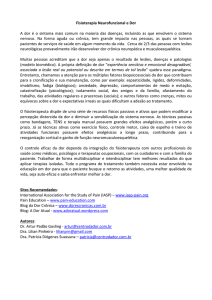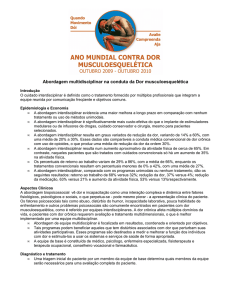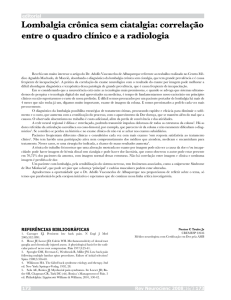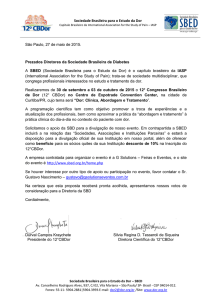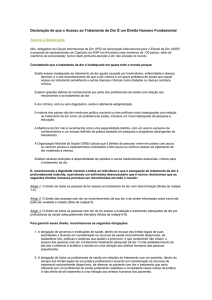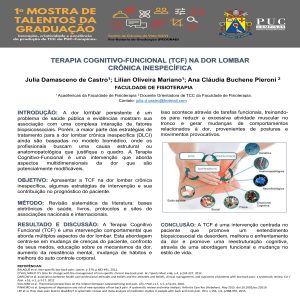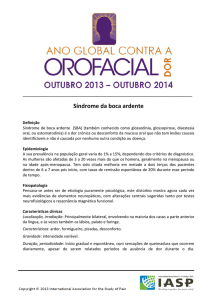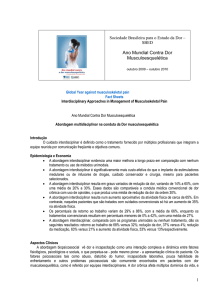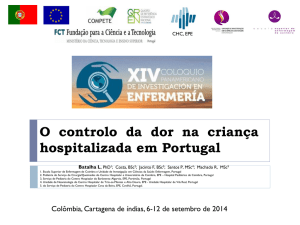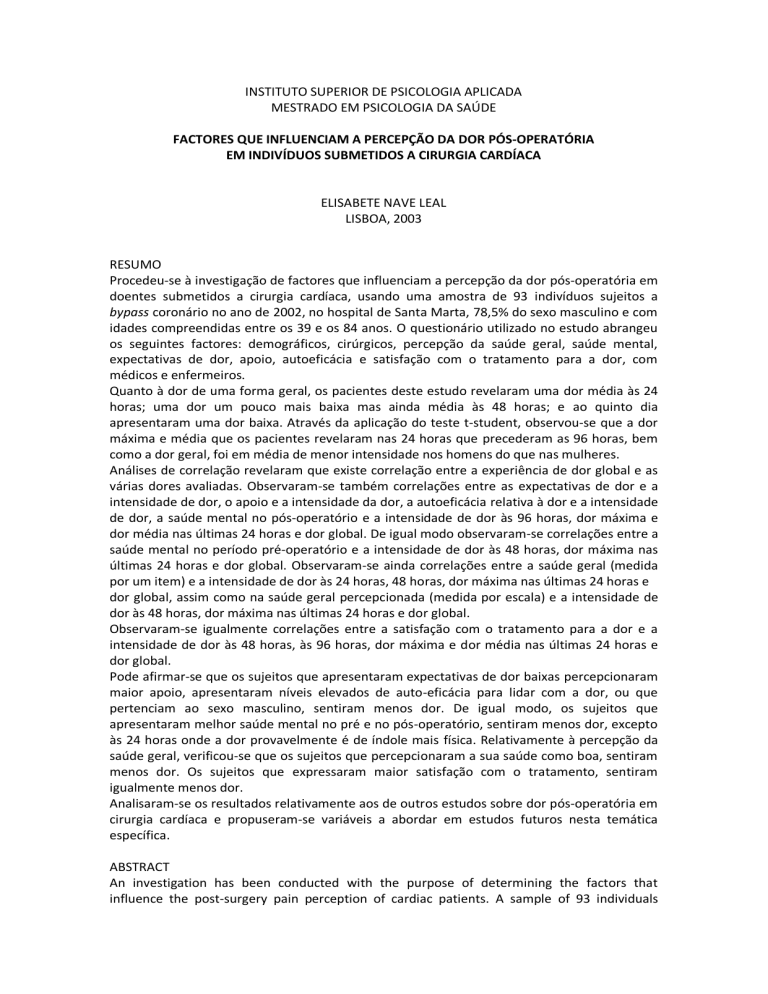
INSTITUTO SUPERIOR DE PSICOLOGIA APLICADA
MESTRADO EM PSICOLOGIA DA SAÚDE
FACTORES QUE INFLUENCIAM A PERCEPÇÃO DA DOR PÓS-OPERATÓRIA
EM INDIVÍDUOS SUBMETIDOS A CIRURGIA CARDÍACA
ELISABETE NAVE LEAL
LISBOA, 2003
RESUMO
Procedeu-se à investigação de factores que influenciam a percepção da dor pós-operatória em
doentes submetidos a cirurgia cardíaca, usando uma amostra de 93 indivíduos sujeitos a
bypass coronário no ano de 2002, no hospital de Santa Marta, 78,5% do sexo masculino e com
idades compreendidas entre os 39 e os 84 anos. O questionário utilizado no estudo abrangeu
os seguintes factores: demográficos, cirúrgicos, percepção da saúde geral, saúde mental,
expectativas de dor, apoio, autoeficácia e satisfação com o tratamento para a dor, com
médicos e enfermeiros.
Quanto à dor de uma forma geral, os pacientes deste estudo revelaram uma dor média às 24
horas; uma dor um pouco mais baixa mas ainda média às 48 horas; e ao quinto dia
apresentaram uma dor baixa. Através da aplicação do teste t-student, observou-se que a dor
máxima e média que os pacientes revelaram nas 24 horas que precederam as 96 horas, bem
como a dor geral, foi em média de menor intensidade nos homens do que nas mulheres.
Análises de correlação revelaram que existe correlação entre a experiência de dor global e as
várias dores avaliadas. Observaram-se também correlações entre as expectativas de dor e a
intensidade de dor, o apoio e a intensidade da dor, a autoeficácia relativa à dor e a intensidade
de dor, a saúde mental no pós-operatório e a intensidade de dor às 96 horas, dor máxima e
dor média nas últimas 24 horas e dor global. De igual modo observaram-se correlações entre a
saúde mental no período pré-operatório e a intensidade de dor às 48 horas, dor máxima nas
últimas 24 horas e dor global. Observaram-se ainda correlações entre a saúde geral (medida
por um item) e a intensidade de dor às 24 horas, 48 horas, dor máxima nas últimas 24 horas e
dor global, assim como na saúde geral percepcionada (medida por escala) e a intensidade de
dor às 48 horas, dor máxima nas últimas 24 horas e dor global.
Observaram-se igualmente correlações entre a satisfação com o tratamento para a dor e a
intensidade de dor às 48 horas, às 96 horas, dor máxima e dor média nas últimas 24 horas e
dor global.
Pode afirmar-se que os sujeitos que apresentaram expectativas de dor baixas percepcionaram
maior apoio, apresentaram níveis elevados de auto-eficácia para lidar com a dor, ou que
pertenciam ao sexo masculino, sentiram menos dor. De igual modo, os sujeitos que
apresentaram melhor saúde mental no pré e no pós-operatório, sentiram menos dor, excepto
às 24 horas onde a dor provavelmente é de índole mais física. Relativamente à percepção da
saúde geral, verificou-se que os sujeitos que percepcionaram a sua saúde como boa, sentiram
menos dor. Os sujeitos que expressaram maior satisfação com o tratamento, sentiram
igualmente menos dor.
Analisaram-se os resultados relativamente aos de outros estudos sobre dor pós-operatória em
cirurgia cardíaca e propuseram-se variáveis a abordar em estudos futuros nesta temática
específica.
ABSTRACT
An investigation has been conducted with the purpose of determining the factors that
influence the post-surgery pain perception of cardiac patients. A sample of 93 individuals
submitted to coronary bypass in the year of 2002, in the Santa Marta hospital, from which
78,5% where man and presented ages ranging from 39 to 84 years old. The questionnaire used
in the study comprised the following factors: demographic, surgical, general health perception,
mental health, pain expectations, support, self-efficacy, and pain treatment satisfaction with
the nurses and the doctors.
The patients included in this study presented, in general, a medium pain after the first 24
hours; after the first 48 hours they revealed a slightly inferior, but still medium pain level; in
the fifth they presented low pain levels. In this study, and through the t-student test, it was
observed that mans felt less pain than the woman’s in the medium and maximum pain level in
the 24 hours preceding of the 96 hours counting from the surgery.
Correlation analysis where executed and revealed the existence of correlation between the
global pain experience and the several pain variables analyzed, the pain expectations and the
pain intensity, the support and the pain intensity, the self efficacy face to the pain and the pain
intensity, the mental health after the surgery and pain intensity at 96 hours, the maximum and
medium pain in the last 24 hours and the global pain. It was also observed the correlation
between the mental health in the post surgery period and the pain intensity at 48 hours, and
between the maximum pain during the last 24 hours and the global pain. It was also observed
the correlation between general health (measured by one item) and the pain intensity at 24
hours, 48 hours, maximum pain in the last 24 hours and the global pain, and the correlation
between the perception of general health (scale measured) and the pain intensity at 48 hours,
maximum pain in the last 24 hours and global pain. Equally, it was observed the correlation
between the satisfaction with pain treatment and pain intensity at 48 hours, maximum and
medium pain in the 24 hours preceding the 96 hours, and global pain.
It can be stated that individuals that presented lower pain expectations, had a better support
perception, presented high self-efficacy levels face to pain, or belonged to the male sex, felt
less pain. Equally the patients that presented a better mental health in pre and post surgery,
felt less pain. This statement do not applies to the 24 hours because in that moment the pain is
mainly physical. The individuals that presented a higher general health perception felt less
pain. The patients that presented a higher satisfaction level also felt less pain.
Results where analyzed face to the results of other studies about post-surgery pain in cardiac
operations, and new variables where purposed to be used in future studies about the current
theme.

